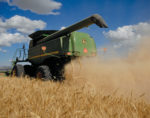Advertise Follow Us
Residue Management
What I've Learned from No-Tilling
Listening To No-Tillers Makes For Better Equipment
Roy Applequist says Great Plains Mfg. has grown up with the no-till industry, adapting along the way to provide better tools for their no-till customer base.
Read More
No One Answer For Handling No-Till Residue
You’ll find significant differences in the way no-tillers handle crop residue depending what part of the country they live and farm.
Read More







